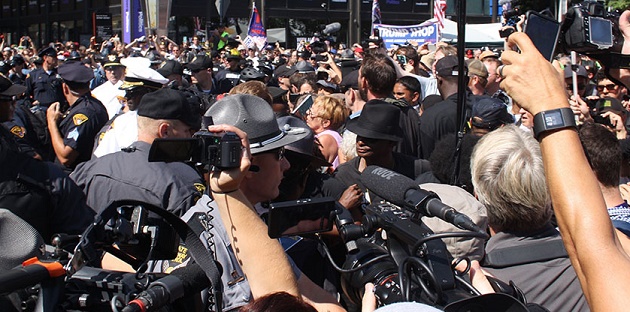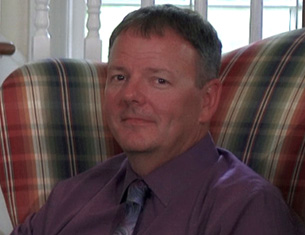Our Community Platform providing Essential Information to Know what is Real
Researchers Track Changes In Police Protests
Publisher's note: The author of this post, Jules Norwood, is a contributor to ECU News Services.
After attending both major political conventions this summer, an East Carolina University sociology professor is shaping new research around large-scale protests and police response tactics.
There is a continuous adaptation and evolution between large-scale protesters and the police dispatched to keep them under control, said Dr. Bob Edwards. "It's sort of a dance, where each side is aware of what the other is doing, and adjusts."
Edwards is working with a team of sociology and criminal justice faculty and students that hails from several institutions - ECU, Western Washington University, University of Wisconsin-La Crosse and Arcadia University - and has been observing and documenting protests since 2001. They monitor the web pages and social media of both protest groups and police in order to attend planned and spontaneous protest events.
There's a delicate and constantly shifting balance between security and free expression, Edwards said. "In many ways, in many people's minds, those are competing ideas, which is one of the broader ideas of this research."

"In both cities the protests and the policing of them remained overwhelmingly peaceful with relatively few instances of conflict or overt contention between police and protesters," Edwards said. There was one significant episode of contention between police and protesters in Philadelphia, but it was mild compared to past political conventions during the Iraq War, Global Justice protests during the 2000s or the Occupy Wall Street movement of 2011, he added.
There was a noticeable difference in the approaches to policing between the two conventions, with a much larger police presence in Cleveland. Edwards said the city of Philadelphia took measures to reduce the number of arrests after facing lawsuits related to the arrests made during past protest events.
"A number of actions the Philadelphia police had previously arrested protesters for were decriminalized for the DNC, indicating a more hands-off policing strategy," he said. "A new citation system was also implemented allowing the police to detain protesters, remove them from the scene, and then issue misdemeanor citations without a formal arrest."
During a pre-demonstration meeting of activists Edwards observed a discussion of how few arrests were being made and what demonstrators would have to do to be arrested, short of violence or property damage.
"Current demonstrators were adapting to a new police strategy, which itself was an adaptation to lawsuits brought by previous demonstrators over prior protest policing strategy," Edwards said.
In Cleveland, approximately 300 bicycle officers were used extensively to manage protesters and bystanders, forming mobile barricade lines to steer marchers into pre-defined routes, forming rings around groups of protesters to separate them from each other or from their audience, and riding through or near small groups of protesters to make their presence known.
"By the third day of the RNC, several activists were observed accompanying protest marches, themselves on bicycles," Edwards said. "They rode in ways that disrupted the bike officers' ability to ride in formation. They seemed to be assessing, experimenting."
The most surprising aspect of the two sets of protests for Edwards and the team was the lack of protest and contention in Cleveland, compared to expectations and to the massive police presence. Several thousand officers were brought in from at least 20 different states to assist the city's police department.
"We have not yet fully compiled our data," he said, "but I think that police significantly outnumbered protesters at most events. The magnitude of officers deployed to small protest events in Cleveland far exceeded deployments in Philadelphia for comparable or even larger events."
As the group's notes and photographs are organized and annotated, the members will compare the two events and look for illustrations of changes in strategy and of how the two police agencies worked differently.
"We are already outlining research articles to write based on the work," Edwards said. "I will be working on developing a presentation on the RNC-DNC project and its background, as well as ways to incorporate some of this into the Department of Sociology website."
Go Back
Police block a Cleveland street to prevent a protest march from deviating from the approved route.
After attending both major political conventions this summer, an East Carolina University sociology professor is shaping new research around large-scale protests and police response tactics.
There is a continuous adaptation and evolution between large-scale protesters and the police dispatched to keep them under control, said Dr. Bob Edwards. "It's sort of a dance, where each side is aware of what the other is doing, and adjusts."
Edwards is working with a team of sociology and criminal justice faculty and students that hails from several institutions - ECU, Western Washington University, University of Wisconsin-La Crosse and Arcadia University - and has been observing and documenting protests since 2001. They monitor the web pages and social media of both protest groups and police in order to attend planned and spontaneous protest events.
There's a delicate and constantly shifting balance between security and free expression, Edwards said. "In many ways, in many people's minds, those are competing ideas, which is one of the broader ideas of this research."

"In both cities the protests and the policing of them remained overwhelmingly peaceful with relatively few instances of conflict or overt contention between police and protesters," Edwards said. There was one significant episode of contention between police and protesters in Philadelphia, but it was mild compared to past political conventions during the Iraq War, Global Justice protests during the 2000s or the Occupy Wall Street movement of 2011, he added.
There was a noticeable difference in the approaches to policing between the two conventions, with a much larger police presence in Cleveland. Edwards said the city of Philadelphia took measures to reduce the number of arrests after facing lawsuits related to the arrests made during past protest events.
"A number of actions the Philadelphia police had previously arrested protesters for were decriminalized for the DNC, indicating a more hands-off policing strategy," he said. "A new citation system was also implemented allowing the police to detain protesters, remove them from the scene, and then issue misdemeanor citations without a formal arrest."
- "By the third day of protests around the DNC, activists prone to acts of disruptive but non-violent, non-destructive acts of civil disobedience as a way to express the intensity of their grievances seemed to have figured out the new policing strategy."</li>
During a pre-demonstration meeting of activists Edwards observed a discussion of how few arrests were being made and what demonstrators would have to do to be arrested, short of violence or property damage.
"Current demonstrators were adapting to a new police strategy, which itself was an adaptation to lawsuits brought by previous demonstrators over prior protest policing strategy," Edwards said.
In Cleveland, approximately 300 bicycle officers were used extensively to manage protesters and bystanders, forming mobile barricade lines to steer marchers into pre-defined routes, forming rings around groups of protesters to separate them from each other or from their audience, and riding through or near small groups of protesters to make their presence known.
"By the third day of the RNC, several activists were observed accompanying protest marches, themselves on bicycles," Edwards said. "They rode in ways that disrupted the bike officers' ability to ride in formation. They seemed to be assessing, experimenting."
- "As police make more use of bicycle officers, my colleagues and I expect to see more protesters on bicycles testing the limits of this emerging police tactic, thinking of ways to incorporate bicycles into protests, developing new ways to impede or disrupt police efforts to control future protests."
The most surprising aspect of the two sets of protests for Edwards and the team was the lack of protest and contention in Cleveland, compared to expectations and to the massive police presence. Several thousand officers were brought in from at least 20 different states to assist the city's police department.
"We have not yet fully compiled our data," he said, "but I think that police significantly outnumbered protesters at most events. The magnitude of officers deployed to small protest events in Cleveland far exceeded deployments in Philadelphia for comparable or even larger events."
- "Similarly, the amount of press personnel on hand in Cleveland seemed equally excessive ... The press presence at times overwhelmed protest actions and impeded police efforts to manage events."
As the group's notes and photographs are organized and annotated, the members will compare the two events and look for illustrations of changes in strategy and of how the two police agencies worked differently.
"We are already outlining research articles to write based on the work," Edwards said. "I will be working on developing a presentation on the RNC-DNC project and its background, as well as ways to incorporate some of this into the Department of Sociology website."
| Workshop Inspires, Supports New Elementary Science Teachers | East Carolina University, School News, The Region, Neighboring Counties | ECU's Coprich Gives Back To His Hometown |
Latest Neighboring Counties
|
Republicans Bokhari and Driggs retain seats on city council.
Published: Tuesday, March 26th, 2024 @ 12:50 am
By: Carolina Journal
|
|
Members of the North Carolina Rural Health Association (NCRHA) visited Washington, D.C., on Feb. 14, 2024, to meet with elected officials and advocate for policies to improve access to care in rural areas.
Published: Wednesday, February 28th, 2024 @ 12:51 am
By: Eastern NC NOW Staff
|
|
The US Supreme Court will not take the case of Virginia-based owners of a Dare County beach home who challenged the county's COVID-related shutdown in 2020.
Published: Tuesday, February 6th, 2024 @ 10:14 pm
By: Carolina Journal
|
|
The North Carolina State Fair is set for the Raleigh state fairgrounds from October 12-22, 2023
Published: Friday, February 2nd, 2024 @ 9:01 am
By: Carolina Journal
|
|
A $2.5-billion-dollar bond referendum is slated to be placed on the November ballot this year, as Charlotte-Mecklenburg Schools (CMS) looks for support to fund 30 different projects in the school district.
Published: Sunday, January 14th, 2024 @ 10:08 am
By: Carolina Journal
|
|
Five Asheville-area residents are suing the city in federal court for refusing to appoint them to the local Human Relations Commission. The residents claim they were rejected because they are white.
Published: Saturday, December 9th, 2023 @ 11:53 am
By: Carolina Journal
|
|
Federal grant expands midwifery care for North Carolina
Published: Wednesday, November 29th, 2023 @ 2:59 pm
By: ECU News Services
|
|
Pirates achieve historic sponsored activities funding
Published: Tuesday, November 28th, 2023 @ 10:03 am
By: ECU News Services
|
|
Innovative new MBA pathway provides leadership experiences for students, companies
Published: Saturday, November 18th, 2023 @ 10:42 am
By: ECU News Services
|






















